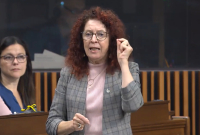Support strong Canadian climate journalism for 2025
Our thoughts are with the Athabasca Chipewyan community because this year is particularly hard on them. We must show solidarity and do more to stop what evidence shows is a flagrant case of environmental racism.
On June 2, Chief Allan Adam urged the evacuation of more than 1,000 people as wildfires raged in northern Alberta, just months after he had received reports regarding a leak of toxic wastewater at Imperial Oil's Kearl oilsands mine affecting his community’s land and water.
With hundreds of blazes burning out of control, Canada confronts a record early wildfire season that, by the end of June, scorched 2.7 million hectares. The increasing frequency and severity of forest fires in Canada are linked to climate change, with a new peer-reviewed study showing “that 37 per cent of the total burned forest area in Western Canada and the United States between 1986 and 2021 can be traced back to 88 major fossil fuel producers and cement manufacturers.”
Rising temperatures, prolonged droughts and changing precipitation patterns contribute to drier conditions and increased fire risk. The Athabasca Chipewyan First Nation, like many Indigenous communities, disproportionately bears the brunt of climate change impacts despite having contributed minimally to global greenhouse gas emissions.
And that is not all.
Imperial’s Kearl mine disaster is a scandal due to the quantity of toxic fluid that entered the environment and the fact Indigenous communities were kept in the dark for nine months. The environmental impact of this disaster is expected to be significant, with dire consequences for wildlife and Indigenous communities downstream, such as the Dene and Chipewyan Nations.
However, it would be misguided and dangerous to interpret this event as an unforeseen accident. This leak was made possible by the fact that in Canada, we ask polluters to set rules for pollution prevention, and unless we learn from the numerous oil spill cases, they will continue to occur again and again.
On April 17, Chief Adam told a House of Commons committee, “All trust with the Alberta government has been broken and it’s been broken for a long time. It is clear that they cannot be trusted to oversee this mess. What I take from this is that … in this country … you can dump 5.5 million litres of toxic sludge into the environment — 5.5 million litres in one day! When I went to the Imperial site, they said that place was leaking for three days!”
For at least 10 months, four tailing ponds at Imperial Oil’s Kearl facility have been leaking toxic sludge into the environment. The Alberta Energy Regulator and Imperial Oil failed to inform Indigenous communities downstream, despite regularly discussing the disaster behind closed doors.
It took a second incident, which released an additional 5.3 million litres in late February, for the communities and the public to be notified.
Tailings “ponds” are, in fact, massive reservoirs of toxic waste created by the oil industry. They seep into groundwater, their volatile toxic compounds go into the air, and they are lethal to thousands of migratory birds that mistake tailing ponds for safe landing sites.
The members of the Indigenous communities who live downstream experience high rates of cancers and respiratory diseases, which numerous experts have attributed to the toxins coming from the ponds.
The consequences are devastating but are symptomatic of the way Canada writes its environmental policy.
As I have warned before, governments disproportionately consult with industry players when developing regulations, assuming polluters know best how to deal with their pollution. This system bakes in the law a conflict of interest: companies are designed to cut costs where they can, leading them to advocate for policies that have cost minimization, not pollution prevention, as a goal. The oilsands tailings ponds illustrate the failure of this approach.
When Imperial Oil’s Kearl project was approved, the company itself cautioned that the ground for tailings ponds was porous and their knowledge about the subsurface was incomplete. The federal-provincial panel reviewing the project approved it anyway, relying on the fact that Imperial would install systems to capture the seepage.
When tailings ponds got too large to ignore in the late 2000s, the Alberta Energy Regulator (AER) put forward Directive 074, a set of requirements for the management and reclamation of tailings ponds. The targets it set out for tailings volume reduction and reclamation were ambitious — and every company failed to meet them.
Then came the weaker Directive 085, under which the AER works with individual companies to develop fluid tailings management plans. While companies regularly meet their targets under this new directive, the problem itself has only grown — since the initiative was put in place, the total tailings volume grew by 22 per cent.
The Imperial Oil leak comes after decades of permissive governments. I had a front-row seat to the devastating railway incident that took place in Lac-Mégantic, Que., a decade ago.
The story there may sound eerily too familiar: regulations pertaining to the transportation of oil via rail were crafted in close collaboration with the industry, and once the rules were set, companies were expected to self-regulate.
Companies significantly cut back on key security measures previously in place, and on July 6, 2013, a train derailed and exploded, killing 47 people and destroying half the nearby town.
Policymakers must learn from Lac-Mégantic, from the Imperial Oil disaster, from the record wildfire season we are all enduring and prioritize prevention and rigorously apply the “polluter-pays” principle enshrined in our environmental laws.
It is time for Canada, Alberta and the Alberta Energy Regulator to do what governments are meant to do — design, implement and enforce laws that protect people.
Independent Sen. Rosa Galvez chaired the Senate Standing Committee on Energy, the Environment and Natural Resources in the 42 Parliament and currently serves on the Senate Standing Committee on National Finance, which oversaw the federal economic response to the COVID-19 pandemic.
In November 2020, she published a white paper on Building Forward Better: A Clean and Just Recovery from the COVID-19 Pandemic proposing a transformative vision to achieve greater overall collective well-being and solidarity among all Canadians.
Originally from Peru, she is one of Canada’s leading experts on pollution control and its effects on human health. She has a PhD in environmental engineering from McGill University and has been a professor at Université Laval à Québec since 1994, heading the civil and water engineering department from 2010 to 2016. She specializes in water and soil decontamination, waste management and residues, and environmental impact and risk assessment.






Comments
we are waiting for this to happen. and waiting and waiting.
given the failure to hold government accountable for criminal negligence of protecting the public vs. corporate profit making leading to mass murder during Covid so far, Im in despair
The plain and simple truth is buried in this article, obfuscated by the headline: "companies are designed to cut costs where they can, leading them to advocate for policies that have cost minimization, not pollution prevention, as a goal." It wouldn't matter to the oil companies if the folks downstream were black Africans or white Christian colonists - ask the Nigerians or the farmers living next to abandoned, leaky sour-gas (highly poisonous H2S) wells in the more southerly parts of Alberta.
The problem is not racism, it is industrial capitalism and it's ability to externalize industrial costs, together with the accumulated wealth that lets them buy the kind of government that permits them to get away with it.
I would agree in a generalized way, but there is a difference between me being forced to occasionally sniff H2S as a kid growing up in the suburbs of Calgary and having to drink several litres a day of water from the Ghost and Glenmore reservoirs that were directly (and secretly) contaminated by upstream industrial effluent.
The latter did not happen to a major Alberta city, of course, but the legacy of industrial and other abuses of Indigenous communities is Canada's most shameful historical act.
It will probably take a massive lawsuit to bring justice to Indigenous peoples whose rights are specifically protected under the Constituion.
Droughts, tailing pond leaks, wild fires... and still the Alberta UCP is once again denying that fossil fuels are going to be as earth crippling as all of science is now proving.
Florida coral reefs, the wild rise in sargassum sea weed. Texas heatwave, 80 million US citizens are under a record heat wave.
So we will just wait until is so over coming, that it ends our ability to feed our selves.